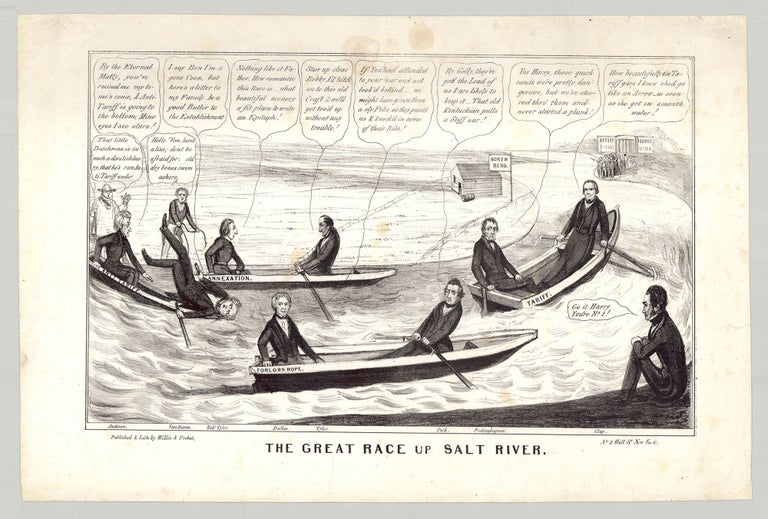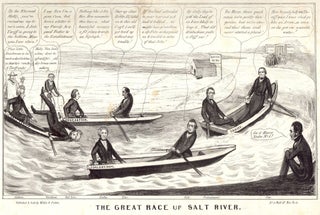The Great Race Up Salt River.
New York: Published & Lith. by Willis & Probst, [1844]. Lithograph, 10.75” x 17.25” plus title and margins. A captivating and very rare satire of the presidential campaign of 1844, employing the popular metaphor of “Up Salt River” to denote political peril or defeat. Whig nominee Henry Clay and his running mate Theodore Frelinghuysen, in their boat Tariff, lead the other candidates in the race up Salt River. Lying just ahead on the left bank is a cabin with a sign reading “North Bend” and on the right bank the White House, representing victory. Clay cheerfully exclaims “How beautifully the Tariff goes I knew she’d go like an Arrow as soon as she got in smooth water!” A supporter sitting on the riverbank cries out “Go it Harry You’re No. 1!” Behind Clay and Frelinghuysen are the ultimate winners of the election, Democratic nominees James K. Polk and George M. Dallas in their boat Forlorn Hope (Polk was a dark horse candidate). Also on the river are John Tyler—the incumbent during the election—and his son Robert in their boat Annexation. Trailing in the boat Anti-Tariff are former Presidents Andrew Jackson and Martin Van Buren, the latter a candidate earlier in 1844, who is shown falling in the bow of the boat and driving it under water, signifying his departure from the race. A farmer with a pitchfork standing on the shore remarks “That little Dutchman is in such a devilish hurry, that he’s run Anti Tariff under.” Clay and the Whigs ran on a platform emphasizing tariffs and internal improvements, issues which no longer resonated with voters, and waffled on the annexation of Texas, an issue championed by Tyler and embraced by Polk, ultimately leading to his victory. A former Whig, Tyler was expelled from the party for vetoing Whig legislation, and had hoped to win re-election as an Independent on the issue of annexation, but dropped out and endorsed Polk. Van Buren had failed to win the Democratic nomination due to his rejection of annexation and the opposition of Andrew Jackson. The use of the term “up Salt River” to indicate a candidate’s failure to win an election became popular in the second quarter of the 19th century. It is said to have originated in an incident occurring during the presidential campaign of 1832. Running as the National Republican candidate against Democrat Andrew Jackson, Henry Clay hired a boatman to row him up the Ohio River to Louisville to make a speech. “The boatman, said to be a Jackson man, rowed Clay up Salt River [a tributary of the Ohio] instead, and Clay failed to reach Louisville in time for his speech. His defeat for the Presidency brought later derisive references to this incident…”—(Dictionary of American History, NY, 1940). The sentiment in this print is akin to another 1844 print, entitled Polk & Co. Going Up Salt River (Reilly 1844-34; Weitenkampf, p. 80), in which James Polk and the other presidential candidates follow a steamship (representing a ballot box) up Salt River. Lithographers William R. Willis and John Probst were active from 1838 to 1849 and specialized in political cartoons, military prints, and portraits. Peters makes note of two Willis & Probst cartoons: Tyler Displayed and Impure Spirits, both evidently relating to the election of 1844. No copies recorded in OCLC. Not in Reilly, which records six other Salt River cartoons for the 1844 election. Not in Weitenkampf. REFERENCES: Peters, America on Stone, pp. 403-404; Last, The Color Explosion, p. 240. CONDITION: Good, a few neatly repaired short tears in margins, two light circular stains at center top, some light spotting foxing.
Item #5884
Price: $4,000.00



